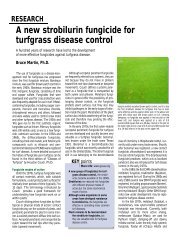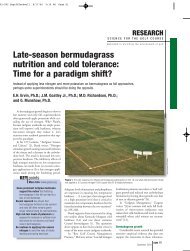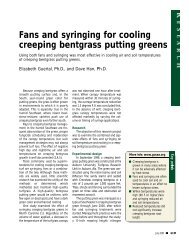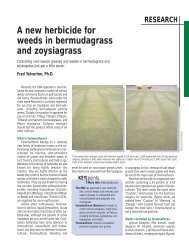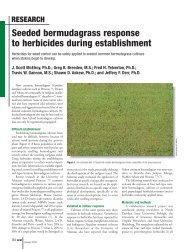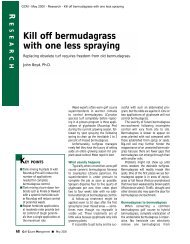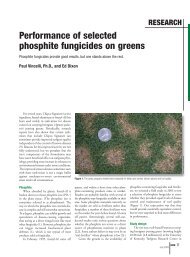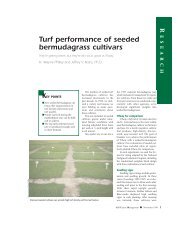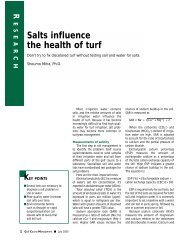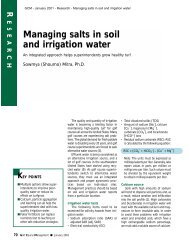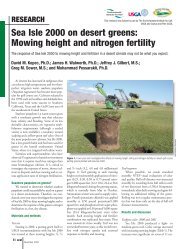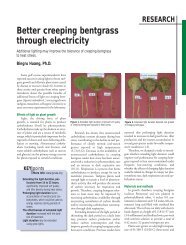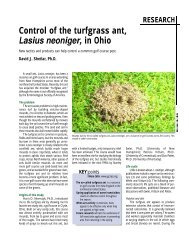RESEARCHPrimary stressesI propose that <strong>organic</strong> <strong>matter</strong> accumulationand associated adverse soil physicalresponses are the <strong>primary</strong> stresses on ultradwarf<strong>bermudagrass</strong>es, because <strong>in</strong> most<strong>in</strong>stances they occur before other commonlyreported stresses are observed. As with creep<strong>in</strong>gbentgrass, subsurface layers of f<strong>in</strong>es, surfacecompaction or a push-up green with toomany f<strong>in</strong>es can create the same high-moistureand low-oxygen conditions caused by excessive<strong>organic</strong> <strong>matter</strong>. However, on high-sandgreen mixes, these conditions are most oftencaused by too much <strong>organic</strong> <strong>matter</strong>. Push-up<strong>bermudagrass</strong> <strong>greens</strong> frequently conta<strong>in</strong>more clay and silt than high-sand <strong>greens</strong>, butvigorous topdress<strong>in</strong>g often creates a sand cap,which can exhibit surface <strong>organic</strong> <strong>matter</strong>accumulation just as a high-sand green does.Conditions favor<strong>in</strong>g <strong>organic</strong> <strong>matter</strong>On <strong>bermudagrass</strong> <strong>greens</strong>, <strong>organic</strong> <strong>matter</strong>accumulation seems to be associated with oneor more of the conditions discussed below.Grass typeUltradwarf <strong>bermudagrass</strong> cultivars have atendency to accumulate <strong>organic</strong> <strong>matter</strong>with<strong>in</strong> the surface zone (Figure 2). The densesurface and very close mow<strong>in</strong>g heights usedon these grasses also make <strong>in</strong>corporation oftopdress<strong>in</strong>g difficult. Seashore paspalum on<strong>greens</strong> is less prone to develop<strong>in</strong>g excessivesurface <strong>organic</strong> <strong>matter</strong> than the ultradwarf<strong>bermudagrass</strong>es if it is ma<strong>in</strong>ta<strong>in</strong>ed accord<strong>in</strong>gto paspalum requirements and not as a<strong>bermudagrass</strong> (2). For seashore paspalum,reduc<strong>in</strong>g nitrogen rates and irrigat<strong>in</strong>g on adeeper and less frequent basis are effective <strong>in</strong>prevent<strong>in</strong>g excessive <strong>organic</strong> <strong>matter</strong>.Anaerobic conditionsWhenever oxygen with<strong>in</strong> the 0-2-<strong>in</strong>ch (0-5.1-centimeter) zone is limited enough to createanaerobic conditions, decomposition of<strong>organic</strong> <strong>matter</strong> greatly decl<strong>in</strong>es because microbialactivity slows. Thus, when <strong>organic</strong> <strong>matter</strong>accumulation is sufficient to limit aerationwith<strong>in</strong> this zone, reduced microbial activitywill probably cause even more accumulation.Prolonged wet weather or daily irrigation isespecially conducive to enhanc<strong>in</strong>g <strong>organic</strong><strong>matter</strong> buildup because the moist conditionsma<strong>in</strong>ta<strong>in</strong> a consistently anaerobic status.On a high-sand green, soil oxygen may beadequate for deeper roots below the zone ifcultivation operations have created sufficientFigure 1. Th<strong>in</strong>n<strong>in</strong>g associated with <strong>bermudagrass</strong> decl<strong>in</strong>e of Cynodon species turf (Repr<strong>in</strong>ted from Compendium ofTurfgrass Diseases, 2nd ed., APS Press, 1992).macropores to allow oxygen diffusion acrossthe surface zone. However, with<strong>in</strong> the surfacezone, conditions are more anaerobic.Anaerobic conditions at the surface often stimulategrasses to produce adventitious or surfaceroots, which add to the surface <strong>organic</strong> <strong>matter</strong>biomass. Poor <strong>in</strong>ternal dra<strong>in</strong>age deeper with<strong>in</strong>the soil profile would cause a waterlogged conditionat the surface and foster <strong>organic</strong> <strong>matter</strong>accumulation dur<strong>in</strong>g wet weather.Acidic conditionsAn acidic condition <strong>in</strong> the first <strong>in</strong>ch (2.5centimeters) of the soil surface can occur onacid sands <strong>in</strong> humid regions, when acidic nitrogenfertilizers are used or when rout<strong>in</strong>e wateracidification is practiced. When soil is sampledat 3 to 4 <strong>in</strong>ches (7.6-10.2 centimeters), low pHat the surface may not be apparent. Soil pHbelow 5.5 greatly restricts the growth of bacterialpopulations that are important <strong>in</strong>decompos<strong>in</strong>g more-resistant <strong>organic</strong> <strong>matter</strong>.Poor air dra<strong>in</strong>age or humid weatherWhen the surface zone does not rapidlydry after irrigation or ra<strong>in</strong>, longer periods ofanaerobic conditions are favored (Figure 3).Secondary problems or symptomsDiverse secondary problems or symptomsarise <strong>in</strong> response to the adverse soil physicalconditions created by excessive <strong>organic</strong> <strong>matter</strong>,and several can occur at one time. Oftena green fails because of multiple <strong>primary</strong> andsecondary problems rather than a s<strong>in</strong>glecause. Common secondary problems <strong>in</strong>cludethe follow<strong>in</strong>g (3,6).Limited root<strong>in</strong>g depthA tendency for reduced root<strong>in</strong>g depthwith<strong>in</strong> one to two years after establishmenthas been commonly observed on <strong>bermudagrass</strong><strong>greens</strong> with high sand content, eventhough <strong>bermudagrass</strong>es have the geneticcapability to be deep rooted. Limited rootdepth may be a result of one or more factors.Organic <strong>matter</strong> can limit oxygen diffusionacross the surface zone <strong>in</strong>to the deeper rootmedia, especially <strong>in</strong> wet weather. Rootsrequire oxygen 24 hours a day, and oxygendemand by the plant and microorganisms canbe high <strong>in</strong> summer. Without adequate oxygen,root growth rate decl<strong>in</strong>es, and undersevere oxygen stress, roots may die back.Creat<strong>in</strong>g temporary macropores by cultivationoperations across this zone can helpma<strong>in</strong>ta<strong>in</strong> better oxygen diffusion. Integrat<strong>in</strong>gsufficient topdress<strong>in</strong>g sand <strong>in</strong>to the zone canenhance water and air flow.Limited oxygen with<strong>in</strong> the zone stressesroots and may cause root prun<strong>in</strong>g. This obviously<strong>in</strong>fluences deeper roots.May 2004GCM 103
RESEARCHFigure 2. Ultradwarf <strong>bermudagrass</strong> <strong>greens</strong> show evidenceof excessive <strong>organic</strong> <strong>matter</strong> <strong>in</strong> the top 2 <strong>in</strong>ches ofsoil two years after establishment.Prolonged cloudy weather and close mow<strong>in</strong>gmay contribute to root decl<strong>in</strong>e by provid<strong>in</strong>gless favorable conditions for produc<strong>in</strong>g theplant carbohydrates (food) necessary to ma<strong>in</strong>ta<strong>in</strong>current roots or generate new ones (3).Root and crown tissue <strong>in</strong>juryAll liv<strong>in</strong>g tissues with<strong>in</strong> the surface 2<strong>in</strong>ches (5.1 centimeters) must have adequateoxygen to ma<strong>in</strong>ta<strong>in</strong> viability. Prolongedexposure to low oxygen can cause root andlower crown <strong>in</strong>jury, mak<strong>in</strong>g these tissues lessviable and more susceptible to root pathogensand drought stress if they occur. Thus, lack ofoxygen and not just root-rot organisms maycause root rot or lower crown rot.Inhibition of nutrient and water uptakeThe comb<strong>in</strong>ation of restricted root<strong>in</strong>gdepth and <strong>in</strong>jury to root or crown tissue<strong>in</strong>hibits nutrient and water uptake. Whenexposed to low-oxygen conditions, even relativelyhealthy roots are less efficient at nutrientand water uptake. When roots become so limitedthat frequent irrigation becomes necessary,the surface zone then rema<strong>in</strong>s moist most ofthe time, which promotes low oxygen and limitedroot<strong>in</strong>g conditions. Although cationexchange capacity (CEC) tends to be adequatefor nutrient retention with<strong>in</strong> 2-4 centimoles/kilogram,most of the CEC resideswith<strong>in</strong> the surface 0-2 <strong>in</strong>ches (0-5.1 centimeters)<strong>in</strong> the <strong>organic</strong> <strong>matter</strong>. When roots areshallow, fertilization is a challenge. Dur<strong>in</strong>gdrier periods, frequent irrigation is required toavoid drought stress. With a limited root systemand roots that may not be very healthy,spoon-feed<strong>in</strong>g all nutrients is necessary.Bermudagrass decl<strong>in</strong>e and root rotRoot rot associated with Gaeumannomycesspecies is probably the most recognized root-rot104 GCM May 2004Photos courtesy of P. O’Brien and C. Hartwiger<strong>in</strong>jury, but other causes may be anthracnosebasal rot, Helm<strong>in</strong>thosporium species and Pythiumspecies. Prolonged periods of ra<strong>in</strong>y weather willtrigger root-rot activity. The comb<strong>in</strong>ation of prolongedcloudy and wet weather is especially conduciveto root rot development: Cloudy weathercan place carbohydrate stress on roots while foster<strong>in</strong>ga moist surface, which favors the diseaseorganism and low-oxygen stress on the root andlower crown tissues (3). A high-sand surface conditionwould allow excess water to dra<strong>in</strong>, the surfaceto dry, and oxygen with<strong>in</strong> the surface to beadequate.The important issue is whether thesuper<strong>in</strong>tendent approaches the problembeliev<strong>in</strong>g the <strong>primary</strong> problem is a rootpathogen or excessive <strong>organic</strong> <strong>matter</strong> that createsconditions conducive to root rot. Whenroot-rot organisms are active, it is importantto focus on treat<strong>in</strong>g the disease, but, <strong>in</strong> thelonger term, controll<strong>in</strong>g the <strong>organic</strong> <strong>matter</strong>may be the way to reduce the frequency ofthe problem and fungicide treatments.In my experience, the <strong>organic</strong> <strong>matter</strong> zoneis very effective <strong>in</strong> screen<strong>in</strong>g the fungicidefrom the organisms below the surface zone or<strong>in</strong> the lower region of the zone. Thus, super<strong>in</strong>tendentsmay wish to consider a solid t<strong>in</strong>eoperation ( 1 ⁄4 <strong>in</strong>ch [6.4 millimeters] <strong>in</strong> diameter)or a HydroJect operation just beforefungicide application to allow the fungicide topenetrate though the zone.Other secondary problemsOther secondary problems <strong>in</strong>clude thefollow<strong>in</strong>g.• Algae.• Soft, soggy surfaces. If water <strong>in</strong>filtrationdecl<strong>in</strong>es too much, the surface may rema<strong>in</strong>too soggy or waterlogged and prone to track<strong>in</strong>gfrom vehicles.• Greater potential for <strong>in</strong>tracellular freez<strong>in</strong>gdamage dur<strong>in</strong>g wet periods of late w<strong>in</strong>terand early spr<strong>in</strong>g may occur <strong>in</strong> the morenorthern areas of <strong>bermudagrass</strong> adaptation.• Excessive dry<strong>in</strong>g, desiccation and extra-cellularfreez<strong>in</strong>g of tissues <strong>in</strong> the upper surface ofthe high-<strong>organic</strong>-<strong>matter</strong> zone may <strong>in</strong>crease <strong>in</strong>regions with cold w<strong>in</strong>ters without snow cover.• Light frequent irrigation with sal<strong>in</strong>e watercan lead to salt accumulation <strong>in</strong> the <strong>organic</strong><strong>matter</strong> zone and root stress.ManagementThe <strong>primary</strong> reason for this article was toexpla<strong>in</strong> the adverse effects of excessive <strong>organic</strong><strong>matter</strong> <strong>in</strong> the surface zone <strong>in</strong> the context ofproblems observed on <strong>bermudagrass</strong> <strong>greens</strong>. Itis important for super<strong>in</strong>tendents to determ<strong>in</strong>ewhether a problem is a secondary problem orsymptom, or whether it is the result of excessive<strong>organic</strong> <strong>matter</strong> <strong>in</strong> the surface.Proper identification of the <strong>primary</strong> orunderly<strong>in</strong>g problems allows super<strong>in</strong>tendentsto focus on prevent<strong>in</strong>g future problems withless emphasis on crisis management. It isimportant to note, however, that environmentalconditions alone may cause a diseasethat is usually associated with excessive<strong>organic</strong> <strong>matter</strong>, even though excessive <strong>organic</strong><strong>matter</strong> is not present. In such a case, the diseasewould be considered a <strong>primary</strong> problem.Should all <strong>organic</strong> <strong>matter</strong> be removed?As previously noted, <strong>organic</strong> <strong>matter</strong> contentof more than 4-5% (by weight) favorslow aeration and low water <strong>in</strong>filtration. Doesthis mean that all <strong>organic</strong> <strong>matter</strong> should beremoved from putt<strong>in</strong>g <strong>greens</strong>? No!Along the Gulf coast from Florida toLouisiana, golf courses that exhibited very little<strong>organic</strong> <strong>matter</strong> accumulation still had1.5% <strong>organic</strong> <strong>matter</strong> content <strong>in</strong> the 0-2 <strong>in</strong>ch (0-5.1 centimeter) surface zone, and this <strong>organic</strong><strong>matter</strong> was live turf. Liv<strong>in</strong>g and dead <strong>organic</strong><strong>matter</strong> are very difficult to separate, but a backgroundlevel of 1.5% is reasonable. Thesecourses also had very low (



